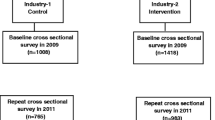Abstract
The objective of this study is to ascertain if higher normal fasting glucose levels are also an independent risk of developing diabetes in an Asian population, and we thus analysed data from a cohort of healthy Japanese workers. We used data from the non-randomised trial on health promotion intervention, High-risk and Population Strategy for Occupational Health Promotion (HIPOP-OHP) Study. Diabetes cases and those who had fasting blood glucose levels equal to or greater than 100 mg/dl at baseline were excluded, and the Cox proportional-hazards model was used for the analysis. During the four-year follow-up of 2212 participants, we found 37 diabetes cases. In the multivariable model, people with blood glucose levels in the 4th quartile had a higher risk of diabetes than those in the bottom quartile; the multivariable-adjusted odds ratio was 2.52. The risk of diabetes abruptly rose in persons with blood glucose levels higher than 94 mg/dl (fourth quartile). A significant linear trend was not observed in the 1st to 3rd quartiles (p=0.726). In conclusion, higher fasting glucose level was associated with the risk of diabetes, and we found a threshold in the association between fasting blood glucose levels and risk of diabetes in an Asian population.
Similar content being viewed by others
References
Tirosh A, Shai I, Tekes-Manova D, Israeli E, Pereg D, Shochat T, Kochba I, Rudich A; Israeli Diabetes Research Group (2005) Normal fasting plasma glucose levels and type 2 diabetes in young men. N Engl J Med 353:1454–1462
McNeely MJ, Boyko EJ, Leonetti DL, Kahn SE, Fujimoto WY (2003) Comparison of a clinical model, the oral glucose tolerance test, and fasting glucose for prediction of type 2 diabetes risk in Japanese Americans. Diabetes Care 26:758–763
WHO Expert Consultation (2004) Appropriate body-mass index for Asian populations and its implications for policy and intervention strategies. Lancet 363:157–163
Okamura T, Tanaka T, Babazono A, Yoshita K, Chiba N, Takebayashi T, Nakagawa H, Yamato H, Miura K, Tamaki J, Kadowaki T, Okayama A, Ueshima H for the HIPOP-OHP research group (2004) The high-risk and population strategy for occupational health promotion (HIPOP-OHP) study: study design and cardiovascular risk factors at the baseline survey. J Hum Hypertens 18:475–485
Tamaki J, Kikuchi Y, Yoshita K, Takebayashi T, Chiba N, Tanaka T, Okamura T, Kasagi F, Minai J, Ueshima H; HIPOP-OHP Research Group (2004) Stages of change for salt intake and urinary salt excretion: baseline results from the High-Risk and Population Strategy for Occupational Health Promotion (HIPOP-OHP) study. Hypertens Res 27:157–166
Gabir MM, Hanson RL, Dabelea D, Imperatore G, Roumain J, Bennett PH, Knowler WC (2000) The 1997 American Diabetes Association and 1999 World Health Organization criteria for hyperglycemia in the diagnosis and prediction of diabetes. Diabetes Care 23:1108–1112
Shaw JE, Zimmet PZ, Hodge AM, de Courten M, Dowse GK, Chitson P, Tuomilehto J, Alberti KG (2000) Impaired fasting glucose: how low should it go? Diabetes Care 23:34–39
Knowler WC, Barrett-Connor E, Fowler SE, Hamman RF, Lachin JM, Walker EA, Nathan DM; Diabetes Prevention Program Research Group (2002) Reduction in the incidence of type 2 diabetes with lifestyle intervention or metformin. N Engl J Med 346:393–403
Durbin RJ (2004) Thiazolidinedione therapy in the prevention/delay of type 2 diabetes in patients with impaired glucose tolerance and insulin resistance. Diabetes Obes Metab 6:280–285
Chiasson JL, Josse RG, Gomis R, Hanefeld M, Karasik A, Laakso M (2002) Acarbose for prevention of type 2 diabetes mellitus: the STOP-NIDDM randomised trial. Lancet 359:2072–2077.
Chiasson JL, Josse RG, Gomis R, Hanefeld M, Karasik A, Laakso M (2004) Acarbose for the prevention of Type 2 diabetes, hypertension and cardiovascular disease in subjects with impaired glucose tolerance: facts and interpretations concerning the critical analysis of the STOP-NIDDM Trial data. Diabetologia 47:969–975
Author information
Authors and Affiliations
Corresponding author
Additional information
An erratum to this article is available at http://dx.doi.org/10.1007/s00592-007-0021-8.
Rights and permissions
About this article
Cite this article
Hayashino, Y., Fukuhara, S., Suzukamo, Y. et al. Normal fasting plasma glucose levels and type 2 diabetes: the high-risk and population strategy for occupational health promotion (HIPOP-CHP) study. Acta Diabetol 44, 164–166 (2007). https://doi.org/10.1007/s00592-007-0258-2
Received:
Accepted:
Published:
Issue Date:
DOI: https://doi.org/10.1007/s00592-007-0258-2




